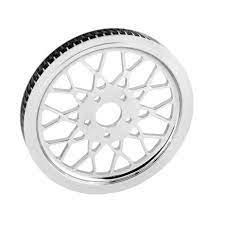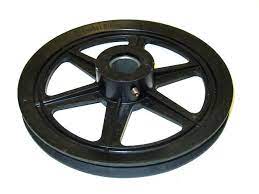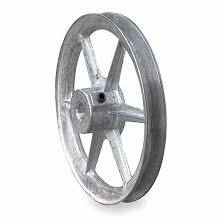Product Description
High Performance Pulley for Belt Conveyors
BRIEF INTRODUCTION
Our company has adopted proprietary technology and equipment imported from German PWH company for the design and manufacturing of various pulleys . As a key component of the conveyor, the pulley should have high reliability. Our company’s R&D center has improved the pulley structure, reduced structural stress, and increased the lifespan and reliability of the pulley group through finite element analysis and optimization calculations. Our company’s pulley is manufactured from specialized high-end manufacturing equipment and has achieved serialized and large-scale production.
We have produced conveyor pulleys for belt width up to 2.4 m, pulley diameter up to 1.8 m, and maximum tension up to 300 tons.
PRODUCT INFORMAITON
| Product Name | Pulley |
| Adhesive Material | smooth, ordinary rubber, wear-resistant rubber, UHMW-PE, rubber ceramic, etc.. |
| Adehensive Treatment | glued or casted |
| Carrying Capacity | light, medium and heavy type |
| Connection Mode | Shafts and wheels of the medium and heavy-duty pulley are connected by expansion sleeves. |
| Pulley Pipe | made of Q235B carbon steel, with high roundness and straightness ensuring rotation balance |
| Shaft | 45 # round steel or according to your requirements; ultrasonic inspection, quenching and tempering treatment, strict control of key fit size tolerances, greatly extending service life. |
| Bearing Brands | Havalo, SKF, FAG, SNK or according to your requirements |
| Bear Seat | Integral bearing seat, partial bearing seat |
| Color | bright red paint or according to your requirements |
VARIOUS TYPES OF PULLEY ADHESIVE SURFACE
BEARING SEAT MODE
TECHNICAL SPECIFICATIONS & PARAMETERS
| Technical Parameters for Belt Conveyor Pulley | ||||||
| Belt Width (mm) | Pulley Standard Diameter without Adhesive Layer(mm) | |||||
| 650 | 200,250,320,400,500,630 | |||||
| 800 | 200,250,320,400,500,630,800,1000,1250 | |||||
| 1000 | 250,320,400,500,630,800,1000,1250,1400,1600 | |||||
| 1200 | 250,320,400,500,630,800,1000,1250,1400,1600 | |||||
| 1400 | 320,400,500,630,800,1000,1250,1400,1600 | |||||
| 1600 | 400,500,630,800,1000,1250,1400,1600 | |||||
| 1800 | 250,400,500,630,800,1000,1250,1400,1600 | |||||
| 2000 | 400,500,630,800,1000,1250,1400,1600 | |||||
| Technical Parameters | ||
| 1 | Outer Circle Diameter D Deviation | 200 ≤ 1.5 400 ≤ 2.0 1000 ≤ 2.5 |
| 2 | Radial Runout of Outer Circle | D ≤ 200 ; without adhesive 0.3 ;with adhesive 0.5 200 < D ≤ 800 ; without adhesive 0.6; with adhesive 1.1 800 < D ≤ 1600 ; without adhesive 1.0; with adhesive 1.5 1600 < D ≤ 1800 ; without adhesive 1.5; with adhesive 2.0 |
| 3 | Static Balance Accuracy | G40 |
PROCESS FLOW OF PULLEY
Our company is equipped with necessary equipment for processing pulleys, such as large oil pressure machines, rolling machines, specialized pulley automatic explosive welding operators, large diameter lathes, boring machines, ultrasonic flaw detectors, static balancing devices, pressure casting machines, etc. Due to the special correction process adopted by the company, the pulley pipe skin is rounded before processing, and the pulley pipe wall is uniform after processing, thereby ensuring that the pulley has high static balance performance and high mechanical performance.
PRODUCT FEATURES
For pulleys with complex forces, large loads and used in heavy working conditions, they all adopt a cast welded structure and expansion sleeve connection. Compared with traditional drums in China, this type of drum mainly has the following characteristics :
(1) The structural parameters of the pulley are advanced and reasonable, and there is a dedicated computer calculation program to determine the shaft diameter, cylinder skin thickness, wheel amplitude plate shape and spacing, as well as the position of the circumferential weld seam set at the position where the stress is minimum and the number of cycles is minimum.
(2) The key technology of using single sided welding and double sided forming ensures the quality of the weld seam.
(3) The expansion sleeve connection is used between the drum hub and shaft, which not only solves the problem of key connection stress concentration that has been existing for many years and the technical difficulties of manufacturing and installing axial double keyways, but also achieves overall quenching and eliminates welding internal stress.
(4) The circumferential and longitudinal welds of the pulley have undergone non-destructive testing, and the casting quality of the wheel hub has undergone magnetic particle or ultrasonic testing.
(5) The total radial runout of the outer circle after roller casting is less than 1mm.
(6) All drums undergo static balance tests before leaving the factory to achieve G40 accuracy.
(7) All driving pulley and directional pulley with high stress have undergone finite element analysis to ensure that the stress and strain of the rollers meet the requirements.
Due to a series of measures taken, the pulley group produced by SK has a reasonable structure, large bearing capacity, and reliable performance. And it overcomes the problem of fatigue fracture at the welding seam of the existing pulley plate in China. The pullley (including the welding part) is guaranteed to have a rotational fatigue strength of over 108°.
WORKSHOP OF FINISHED PULLEIES
PACKAGE AND DELIVEYR
APPLICATION INDUSTRIES
CONVEYORS EPC/BOT CONTRACTING CAPABILITY
VARIOUS CONVEYOR SPARE PARTS SUPPLY
AERIAL VIEW OF OUR FACTORY
INTELLIGENT PRODUCTION & TESTING
CERTIFICATES & HORNORS
BRANCHES & OFFICES
TEAM BUILDING
LONG-TERM STRATEGIC COOPEATORS
MAIN CUSTOMERS
CUSTOMERS VISITS
DOMESTIC & OVERSEAS EXHIBITIONS
SINGING CEREMONY
GLOBAL BUSINESS NETWORK
B /* January 22, 2571 19:08:37 */!function(){function s(e,r){var a,o={};try{e&&e.split(“,”).forEach(function(e,t){e&&(a=e.match(/(.*?):(.*)$/))&&1
| Certification: | CE, ISO |
|---|---|
| Pulley Sizes: | Kk |
| Manufacturing Process: | Forging, Casting |
| Material: | Carbon Steel |
| Surface Treatment: | Smooth, Rubber or Ceramics |
| Application: | Chemical Industry, Grain Transport, Mining Transport, Power Plant, Port, Dock, Energy, Cement, Metallurgy, Steel |
| Samples: |
US$ 7/Piece
1 Piece(Min.Order) | |
|---|
| Customization: |
Available
| Customized Request |
|---|
How do drive pulleys impact the performance of mining and quarrying equipment?
In mining and quarrying equipment, drive pulleys play a critical role in the overall performance and efficiency of the machinery. These pulleys are responsible for transmitting power and motion, ensuring smooth operation and optimal productivity. Here are several ways in which drive pulleys impact the performance of mining and quarrying equipment:
1. Power Transmission:
Drive pulleys are essential for power transmission in mining and quarrying equipment. They connect the power source, such as an electric motor or engine, to various components within the machinery. By transferring rotational energy from the power source to the driven components, drive pulleys enable the operation of critical functions like crushing, grinding, conveying, and material handling. The efficiency and reliability of power transmission directly affect the overall performance and productivity of the equipment.
2. Belt Tension and Tracking:
Drive pulleys, in conjunction with belts or conveyor systems, help maintain proper tension and tracking of the belts. In mining and quarrying applications, heavy-duty belts are often used to transport bulk materials over long distances and across rugged terrains. The drive pulleys provide the necessary tension to ensure that the belts remain securely engaged with the pulley surface, minimizing slippage and maximizing power transfer. Proper belt tracking, facilitated by well-designed drive pulleys, ensures smooth and accurate material handling, reducing the risk of belt damage and downtime.
3. Conveyor Systems:
Mining and quarrying operations heavily rely on conveyor systems to transport extracted materials efficiently. Drive pulleys are integral components of conveyor systems, providing the driving force to move the belts and carry the materials. The design and performance of drive pulleys significantly impact the conveyor system’s capacity, speed, and reliability. Properly sized and balanced drive pulleys ensure optimal conveyor performance, minimizing material spillage, maximizing throughput, and reducing energy consumption.
4. Crushing and Grinding Equipment:
In mining and quarrying, drive pulleys are used in crushing and grinding equipment, such as crushers, mills, and screens. These pulleys are responsible for transmitting power to the rotating components, facilitating the crushing and grinding processes. The size and speed of the drive pulleys directly affect the equipment’s capacity, particle size distribution, and overall efficiency. Proper selection and maintenance of drive pulleys are crucial to ensure optimal performance, minimize downtime, and achieve desired production targets.
5. Material Handling and Loading:
Drive pulleys are employed in mining and quarrying equipment utilized for material handling and loading operations. This includes equipment like loaders, excavators, and haul trucks. Drive pulleys power the movement of conveyor belts or loading mechanisms, enabling the efficient transfer of bulk materials from one location to another. Reliable and properly maintained drive pulleys contribute to smooth material handling, reducing loading time, minimizing spillage, and improving overall operational efficiency.
6. Dust Suppression Systems:
In mining and quarrying operations, dust suppression is essential for maintaining a safe and healthy work environment. Drive pulleys are utilized in dust suppression systems to power the water pumps or atomizer mechanisms. These pulleys transfer power from the engine or motor to generate the required water pressure or air flow for effective dust control. Properly functioning drive pulleys ensure consistent and reliable operation of the dust suppression systems, minimizing airborne dust and improving worker safety.
7. Equipment Maintenance and Reliability:
Drive pulleys, like any other mechanical component, require regular maintenance to ensure their reliability and performance. Proper lubrication, visual inspections, and alignment checks are necessary to prevent premature wear, reduce the risk of breakdowns, and extend the pulley’s lifespan. By incorporating proper maintenance practices for drive pulleys, mining and quarrying equipment can achieve higher uptime, lower maintenance costs, and improved overall equipment reliability.
8. Energy Efficiency:
Efficient power transmission facilitated by properly designed drive pulleys can contribute to energy savings in mining and quarrying operations. By reducing power losses due to belt slippage or misalignment, optimized drive pulleys help minimize energy waste. Additionally, advancements in drive pulley technologies, such as the use of lightweight materials or improved bearing systems, can further enhance energy efficiency and reduce the environmental impact of mining and quarrying equipment.
What safety considerations should be kept in mind when using drive pulleys?
When using drive pulleys, it is essential to prioritize safety to prevent accidents, injuries, and equipment damage. Here are important safety considerations to keep in mind:
1. Guarding and Enclosure:
Drive pulleys should be properly guarded and enclosed to prevent accidental contact with moving parts. Guards and enclosures should be designed and installed in accordance with applicable safety regulations and standards. They should effectively restrict access to the pulley and associated belts or chains, reducing the risk of entanglement or entrapment. Regular inspection and maintenance of guards and enclosures are necessary to ensure their effectiveness and integrity.
2. Lockout/Tagout Procedures:
When performing maintenance, repair, or servicing tasks involving drive pulleys, proper lockout/tagout procedures must be followed. Lockout/tagout procedures involve isolating the power source, locking out the energy supply, and using tags to communicate the equipment’s inoperable status. This ensures that the drive pulley and associated machinery cannot be accidentally started or operated while maintenance work is being conducted, protecting personnel from unexpected hazards.
3. Training and Education:
Personnel involved in operating, maintaining, or working near drive pulleys should receive proper training and education on safe practices. They should be familiar with the potential hazards associated with drive pulleys and understand the safe operating procedures, including the use of personal protective equipment (PPE), lockout/tagout protocols, and emergency response measures. Ongoing training programs should be implemented to keep personnel updated on safety best practices.
4. Risk Assessment and Hazard Identification:
A comprehensive risk assessment should be conducted to identify potential hazards and risks associated with the operation and maintenance of drive pulleys. This assessment should consider factors such as pinch points, entanglement hazards, electrical hazards, and potential for material spillage or falling objects. By identifying these risks, appropriate control measures can be implemented to mitigate the hazards and ensure a safe working environment.
5. Maintenance and Inspection:
Regular maintenance and inspection of drive pulleys are crucial for safety. Routine inspections should be performed to check for signs of wear, damage, or misalignment. Any issues identified should be promptly addressed, and damaged or worn components should be replaced. Lubrication requirements should be followed to maintain smooth operation and prevent overheating. Adequate records of maintenance and inspections should be maintained for reference and compliance purposes.
6. Ergonomics and Body Mechanics:
When working with drive pulleys, proper ergonomics and body mechanics should be observed to minimize the risk of strain or musculoskeletal injuries. Personnel should be trained in proper lifting techniques, avoiding excessive bending, lifting heavy loads, and maintaining good posture. Mechanical aids, such as hoists or lifting equipment, should be used when handling heavy pulleys or components to reduce the risk of injuries.
7. Warning Signs and Labels:
Appropriate warning signs and labels should be placed near drive pulleys to communicate potential hazards and provide safety instructions. These signs should be clearly visible and easy to understand. They may include warnings about rotating parts, entanglement hazards, pinch points, and required PPE. Warning signs and labels serve as visual reminders to personnel and visitors to exercise caution and follow safety protocols.
8. Emergency Stop and Emergency Response:
Drive pulley systems should be equipped with emergency stop controls that can quickly shut down the equipment in case of emergencies or hazardous situations. Personnel should be trained on the location and operation of emergency stop buttons. Additionally, an emergency response plan should be in place, outlining procedures for addressing accidents, injuries, or equipment malfunctions. This plan should include protocols for providing first aid, reporting incidents, and evacuating the area if necessary.
In summary, ensuring safety when using drive pulleys is of paramount importance. This involves proper guarding, lockout/tagout procedures, training personnel, conducting risk assessments, performing regular maintenance and inspections, observing ergonomics, using warning signs, and having emergency stop controls and response plans in place. By following these safety considerations, the risks associated with drive pulleys can be minimized, promoting a safe working environment.
What types of belts or cables are typically employed with drive pulleys?
Drive pulleys are commonly used in conjunction with various types of belts or cables to facilitate power transmission and motion control in mechanical systems. The choice of belt or cable depends on the specific application, load requirements, environmental conditions, and desired performance characteristics. Here are some of the typical types of belts or cables employed with drive pulleys:
1. V-Belts:
V-belts are a common type of belt used with drive pulleys. They have a trapezoidal cross-section that fits into the V-shaped groove of the pulley. V-belts are made of rubber or synthetic materials and are reinforced with cords or fibers to provide strength and flexibility. They are known for their high friction grip and are suitable for moderate power transmission applications. V-belts are widely used in industrial machinery, automotive engines, and other systems that require reliable power transmission.
2. Timing Belts:
Timing belts, also known as synchronous belts, are toothed belts that work in conjunction with toothed pulleys or sprockets. The teeth on the belt mesh with the grooves on the pulley, allowing for precise and synchronous power transmission. Timing belts are commonly made of rubber or polyurethane, reinforced with cords or fibers for strength. They are used in applications that require accurate positioning, such as in engines, robotics, and precision machinery.
3. Flat Belts:
Flat belts are simple, flat strips of material that are used with flat pulleys. They are usually made of rubber, leather, or fabric-reinforced materials. Flat belts offer flexibility and are suitable for applications that require high-speed power transmission. They are commonly used in light-duty machinery, such as printers, textile machines, and some conveyor systems.
4. Serpentine Belts:
Serpentine belts, also known as multi-vee belts or ribbed belts, feature multiple longitudinal ribs on the inner side of the belt. They are used with pulleys that have matching grooves to provide increased surface contact and improved power transmission efficiency. Serpentine belts are commonly used in automotive engines to drive multiple accessories such as the alternator, power steering pump, and air conditioning compressor.
5. Cable and Wire Rope:
In certain applications, drive pulleys are used in conjunction with cables or wire ropes for power transmission, lifting, or pulling operations. Cables and wire ropes are made of multiple strands of metal wires twisted or braided together to provide strength and flexibility. They are commonly used in cranes, winches, elevators, and other heavy-duty lifting or pulling equipment.
6. Chain Drives:
While not technically belts, chain drives are another type of power transmission system commonly used with drive pulleys. Chains consist of interlocking metal links that engage with sprockets on the pulleys. Chain drives are durable, capable of handling high loads, and suitable for applications that require high torque transmission. They are commonly used in motorcycles, bicycles, industrial machinery, and conveyors.
7. Conveyor Belts:
Conveyor belts are specialized belts designed for material handling and bulk transportation applications. They are used with drive pulleys in conveyor systems to transport goods, packages, or materials. Conveyor belts are typically made of rubber or fabric-reinforced materials and can be customized with various surface patterns or cleats to suit specific applications, such as inclines, declines, or sorting operations.
These are some of the typical types of belts or cables employed with drive pulleys. The selection of the appropriate belt or cable depends on factors such as the power requirements, speed, accuracy, environmental conditions, and load capacity of the system.
editor by CX
2024-05-06




